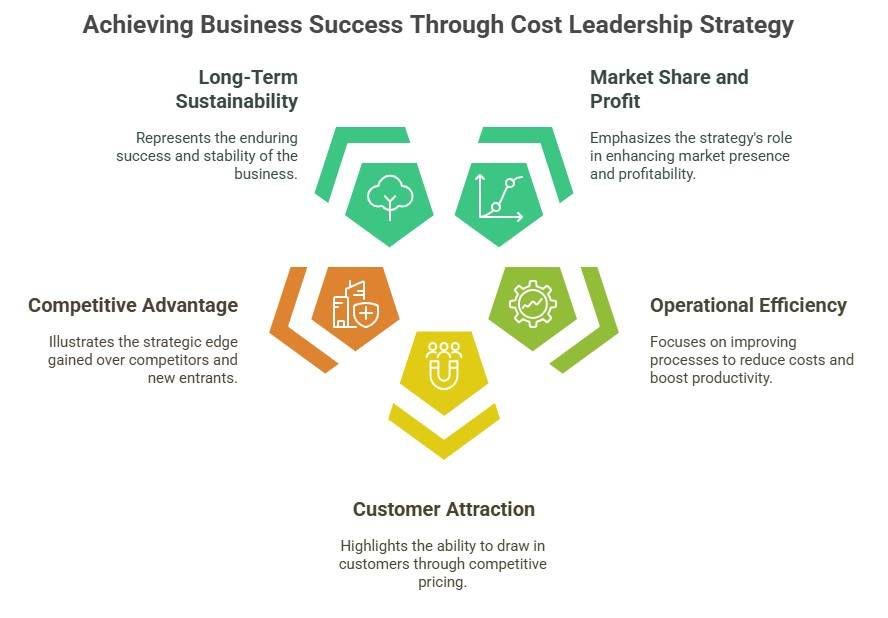Cost Leadership Strategy: Meaning and Example
A cost leadership strategy focuses on becoming the lowest-cost producer in an industry. By minimizing production costs and maintaining quality, businesses can offer lower prices than competitors, attracting price-sensitive customers. This approach requires efficient operations, economies of scale, and tight cost controls to gain a competitive edge.
What is a Cost Leadership Strategy?
A cost leadership strategy involves a business approach focusing on reducing costs across the organization to gain a competitive edge by offering products or services at lower prices than competitors. This strategy emphasizes operational efficiency, economies of scale, and cost minimization to maintain profitability while attracting customers through competitive pricing.
Importance of Cost Leadership Strategy
A cost leadership strategy is crucial for businesses to gain a competitive edge by reducing costs across the organization. This approach involves improving operational efficiency, economies of scale, and cost minimization to offer products or services at lower prices than competitors. Here are the key points highlighting the importance of a cost leadership strategy:
Market Share and Profit
Companies can increase their market share and profit by employing cost-efficiency tactics, as most customers shop only at stores that offer them competitive prices.
Operational Efficiency
Cost leadership emphasizes improving operational efficiency, which helps reduce costs and increase productivity. This leads to higher profits and better financial sustainability.
Customer Attraction
Offering products or services at lower prices than competitors attracts a large customer base, essential for business growth and survival.
Competitive Advantage
Cost leadership provides a competitive advantage by making it difficult for new entrants to enter the market. This strategy helps protect the firm and its existing rivals from new competition.
Profit Margin
Cost leadership increases profit margins by reducing costs and increasing revenue. This is particularly important for businesses operating in competitive markets where prices are constantly undercut.
Long-Term Sustainability
Implementing a cost leadership strategy helps businesses sustain themselves in the long run by reducing financial threats and increasing profitability. This approach ensures that companies can weather market downturns and remain competitive.
Real-Life Examples
Real-life examples of successful cost leadership strategies include Walmart, which has achieved significant cost savings through its efficient supply chain management and logistics, and Xiaomi, which has become a leading smartphone brand by offering high-quality products at affordable prices.
Key Elements of Cost Leadership Strategy
A cost leadership strategy involves several key elements that help businesses achieve a competitive edge by reducing costs and offering products or services at lower prices than competitors. Here are the key elements of a cost leadership strategy:
Cost Minimization
Cost minimization involves reducing costs across the organization by improving operational efficiency, leveraging economies of scale, and controlling expenses.
Pricing Strategies
Pricing strategies involve setting competitive prices that attract price-sensitive customers while maintaining profitability. This includes offering discounts, promotions, and loyalty programs.
Operational Efficiency
Operational efficiency involves streamlining processes, reducing waste, and maximizing productivity through technology, automation, and employee training.
Economies of Scale
Economies of scale refer to reducing average cost per unit as production volume increases. This allows companies to negotiate better prices with suppliers and reduce costs.
Cost Control
Cost control involves monitoring and controlling expenses across all areas of the business strategy, including vendor contracts, supply chain optimization, and employee training.
Product Differentiation
Product differentiation involves sustaining a degree of uniqueness in a product or service to justify pricing and draw in customers. This includes providing distinctive features, benefits, or experiences.
Agile Decision-Making
Agile decision-making involves remaining flexible and adaptable to market trends and customer feedback to maintain a cost advantage.
Implementing Cost Leadership Strategy
Implementing a cost leadership strategy involves several key steps to achieve a competitive edge by reducing costs across the organization. Here are the key elements to include in a cost leadership strategy:
- Conduct a Cost Audit
Conduct a thorough cost audit to identify areas where costs can be reduced. This includes analyzing all aspects of operations, including wages, marketing, product development, business operations, materials, and transportation.
- Set Clear Objectives
Set clear objectives for reducing costs and improving operational efficiency. This includes identifying specific areas where costs can be cut and implementing strategies to achieve these goals.
- Optimize Operations
Optimize operations by streamlining processes, implementing best practices, and leveraging technology to automate routine tasks. This includes investing in employee training and resources to equip the team with the skills and knowledge to handle tasks effectively.
- Engage Employees
Engage employees in the cost-reduction process and provide incentives for cost-saving ideas. This includes recognizing and rewarding employees who contribute to cost-reduction efforts.
- Monitor Performance
Monitor performance regularly to track progress and identify areas for improvement. This includes tracking key performance indicators (KPIs) such as cost reduction, productivity, and customer satisfaction.
- Balance Cost Reduction with Quality
Balance cost reduction with quality by ensuring that cost-cutting measures do not negatively impact the customer experience. This includes monitoring customer feedback and satisfaction metrics to ensure cost reductions do not compromise quality.
Conclusion
A cost leadership strategy involves a combination of cost minimization, pricing strategies, operational efficiency, economies of scale, cost control, product differentiation, and agile decision-making to achieve a competitive edge by offering products or services at lower prices than competitors.









